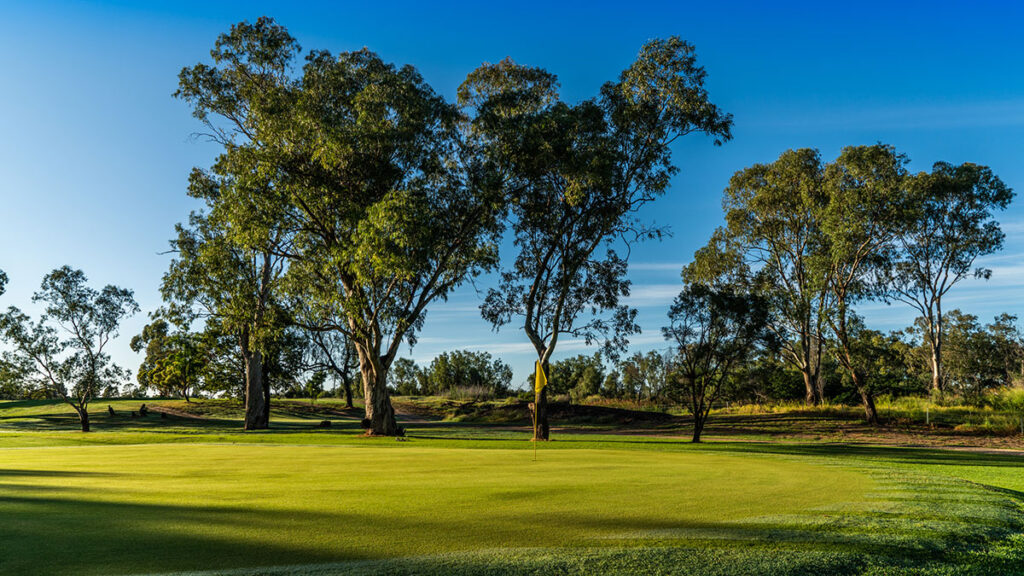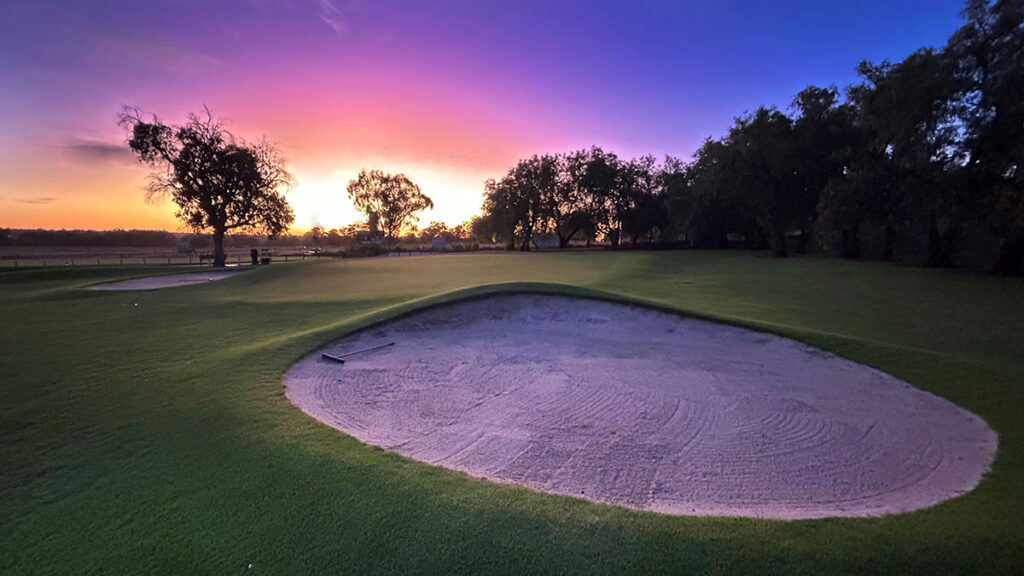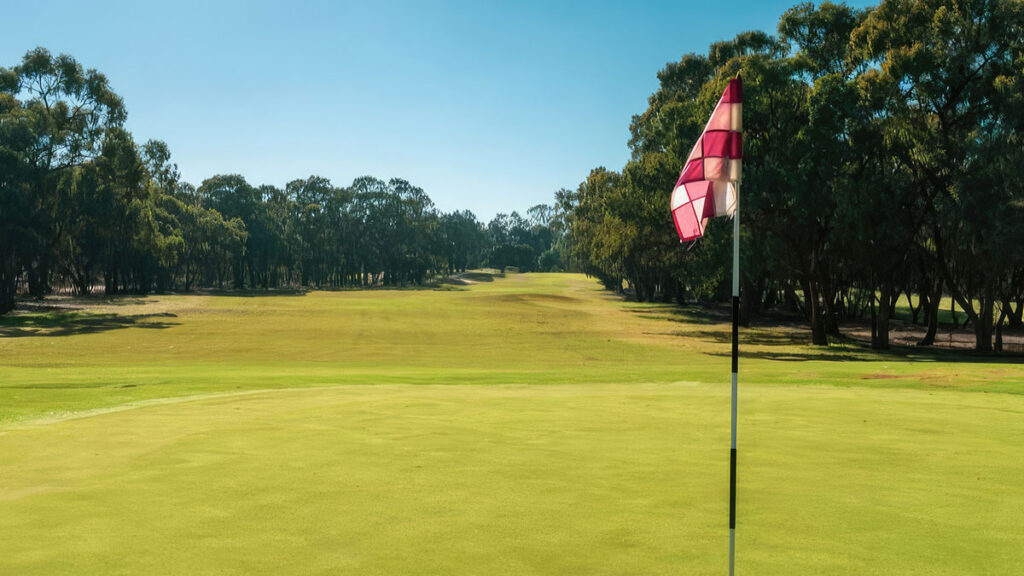Western New South Wales surprises with a range of epic golf experiences, rural gems and memorable locals.
Encompassing a vast area of the state and extending west from the coastline over the Great Dividing Range, Western New South Wales runs to the borders with South Australia and Queensland, and down towards the Murray River region, and covers a diverse range of landscapes: think semi-arid, red earth desert, vast grasslands and fertile river valleys, massive salt lakes, rugged bush country and stark beauty.
If you’re one of the many Australian fringe-dwellers who never leaves the coast then it’s time to pack up the car, camper or caravan and explore a fascinating range of golf destinations.
Never played 18 holes of natural grass fairways (only if there’s been rain) or dirt red (during the dry) plus black sand greens? Head to Hillston Golf Club on the banks of the Lachlan River in the Western Riverina. What about Lightning Ridge Opal Fields Golf Club? Set in a rugged, outback setting among opal mines, it features an unconventional layout, challenging sand greens, black soil fairways and unusual hazards, including opal mineshafts and mullock heaps. Or Cootamundra Country Club on the South West Slopes, one of the oldest golf clubs in New South Wales, established in 1895? And if playing on a course with goats, emus, echidnas and kangas is your thing, along with a classic, arid, red desert sand outback Aussie backdrop, then Broken Hill Golf Club can’t be beaten.
Here are a few more of our favourites:
Oberon Golf Club
Sitting beside serene Lake Oberon in the picturesque Central Tablelands region west of Sydney, the course at Oberon Golf Club is the work of course architect Al Howard. With stunning views of the nearby Blue Mountains, the cool-climate course opened in 1958 with nine holes and sand greens then expanded to 12 holes and, by 1972, 18 holes.
According to general manager Daryl Kelly, Oberon is unique. “With an altitude of higher than 1,000 metres, it’s pretty much an alpine course – in fact, you could even get snowed on during winter – and the views over Lake Oberon are second to none. It’s tough too: a really challenging course that’s hard work – it will find you out! It’s not a walker’s course either. I’m one of only three people who walk, so a cart is a must-have.”
Kelly adds there are quite a few, “OMG, I’ve got to take my phone out!” holes as the changes in elevation and the undulating fairways are incredible.
“There’s a 62-metre drop from the tee on the second to the green then it’s all downhill to the water’s edge,” he explains. “The fourth and fifth run along the edge of the lake, which is a 950-metre water hazard – the longest continual water hazard in the country. The sixth heads back up the hill, taking you across the slope. And I’m talking serious slopes as there are not many flat lies. Considering the sidehills, uphills and downhills, it’s different to anything most golfers will have ever experienced.”
The back nine offers more of the same with the 11th tee looking straight back down to the water again: “The front and back nines are equal in difficulty – but so pretty!” Kelly says.
Although the course is tough to play, it is, at least, a boon to bad bunker players as there aren’t any. Also, even if you’re not the best golfer, playing it is such an experience it’s well worth the effort. And afterwards, at the 19th, there’s a warm, friendly, intimate clubhouse to drown your sorrows in.

Moree Golf Club
Nestled on both sides of the Mehi River in the north-west of the state, Moree Golf Club is an easy walking course that features well-manicured kikuyu fairways and fast couch-grass greens all set within a beautiful treelined landscape.
“The course has a couple of unique aspects; the first being there is not one single bunker: the challenge lies in the fact that we have very small and undulating green complexes, making a premium on accuracy and course management as opposed to the lengthy modern-day monsters,” explains general manager Simon Payne. “Another interesting aspect is that we start with a par 3, made especially challenging as it is located at the entrance to the club and usually draws a crowd, who at times have been known to get quite animated in judging one’s opening tee shot.”
Payne adds, “With an abundance of mature eucalypts framing the fairways, a well-positioned tee ball is a must, and this story continues over all 18 holes. Though a little longer from the tee, the front nine is generally touted as the more friendly of the two nines as the back nine requires several water
carries and challenging doglegs.”
The course’s signature hole? “It would have to be the par-3 17th. While only 142 metres, golfers must navigate the Mehi River with their tee shot while trying to hit the small, raised green that is framed by a majestic grove of eucalypts. If you walk to the 18th tee having made par, you’ll definitely be envied!
“The course favours the thinking golfer, and if you have a consistent shot shape you should find the encounter less daunting: level of difficulty 6.5. The facility boasts a practice fairway, chipping and pitching area and putting green to iron out any deficiencies in one’s game.”
The clubhouse, the centrepiece of the town and which attracts members, the community and visitors, boasts panoramic views across the golf course with glimpses of the river from all three timber decks. “Our Thai restaurant serves up an extensive menu that caters for everyone’s palate. If you fancy a flutter, we also have you covered. Our dedicated sports bar features TAB and Keno facilities as well as an extensive selection of beverages,” Payne says.

Dubbo Golf Club
Dubbo Golf Club, set in the Central West and with a rich history, is a firm favourite among golfers in the know. A stunning 27-hole championship course that was established in 1903, it features well-manicured fairways, challenging bunkers and 11 strategically placed water hazards that wind through picturesque bushland with kangaroos, wallabies, possums and echidna looking on.
Nestled on the banks of the Macquarie River with Golf Links Creek meandering through the course, the layout is designed to test your skills – with a variety of holes requiring precise shot-making and strategic thinking.
“What’s extra special about Dubbo is that it’s the only 27-hole golf course on the western side of the Blue Mountains,” says general manager Melanie Pickett. “This means there are three challenging 18-hole combinations to play. It also means that when a competition is running there are still nine holes available for a social round – so stay for a few days!”
The course is regularly recycled so all 27 holes are kept up to date. This ensures it is maintained to a high standard and never gets run down.
Many will be surprised by unexpected descriptions of the course as a lush oasis! How is that possible in a region that regularly experiences drought?
“A few years ago, during the last drought, we received a substantial donation of water allocation from nearby mining company Alkane Resources and a Regional Sporting Infrastructure grant from the NSW Government,” Pickett says. “Since then, we have upgraded our irrigation system. This has allowed us to maintain the course to a high standard, keep it green and get us through the inevitable drought conditions.”
The club has hosted a number of regional golf events over the past few years, starting with the Women’s NSW Open of Golf in 2020. The ALPG event (now known as the WPGA Tour of Australasia), attracts world-ranked players. In March this year, it hosted the NSW Women’s Open Qualifier and pro-am.
With a well-equipped pro shop, and practice facilities including a chipping range and putting green, the facilities are top-notch. Afterwards, unwind at the warm and inviting club house for a good meal and refreshing drink.
“Visitors, such as Sydneysiders, who come and play the course love it so much they buy houses so they can live here on the course,” Pickett says.

CluBarham
Down on the mighty Murray River and sitting pretty among natural bush surrounds is CluBarham, an 18-hole championship course penned by course architect Ross Watson. Club manager Sienna Voglis describes it as a beautiful course, in great condition 365 days a year, that golfers of all levels of ability can enjoy.
“CluBarham is one of the Murray region’s major golf destinations,” she explains. “We continually use Watson’s blueprint to improve and redefine the layout and quality of play. We recently swapped the nines around and redesigned the first through Centreline Golf Design, which was completed in February this year. The new first now features a multi-tee block design with a raised green and a bunker on the right-hand side. Members voted on swapping the nine in 2022, with the consensus being they had six of the most challenging holes to finish with.
“My favourite holes are the 14th, which has a huge bunker in front of the green – we nicknamed the hole ‘Gallipoli’ – and the 10th, which has two bunkers and a water hazard for players to carry on the left-hand side of the green.”
The club boasts two practice ranges and a practice putting green. “We also have 14 grass tennis courts, a bar with a TAB, and beautiful resort-style accommodation with two-bedroom and three-bedroom apartments and a swimming pool for your golfing escape. RV sites accommodate those with a caravan. Plus, there’s a fully stocked pro shop with friendly staff ready to greet anyone who walks through our doors wanting to play a round of golf,” Voglis says.

Glen Innes Golf Club
Home of the Australian Celtic Festival, held annually each May, Glen Innes is situated in the New England high country in the north of the state, a two-and-a-half-hour drive inland from the coast. The altitude of more than 1,000 metres means that, when playing at Glen Innes Golf Club, you’ll experience distinct seasons – from golden autumns and log-fire winters (and sometimes even snow) to stunning springs and cool summers.
Manager Damien Boylan says the club was founded in 1901 and is especially beautiful in autumn as the course is like a botanical garden, lined with big pines and stately trees that burst into orange and red. There’s also a wide variety of wildlife, including kangaroos, parrots and black cockatoos.
“The club comprises 18 holes with bentgrass greens, very generous fairways (which means you can have confidence using the driver) and is relatively flat, so it’s enjoyable to play and to walk. The greens are in great condition and beautiful to putt on, but they are the protection of the course so take time to line your putts up. The front nine is more open while the back is tighter, and players need to shape a few of their shots,” Boylan explains. “My favourite hole is the 12th. It’s a par 3 over water that plays between 100 and 120 metres. The green slopes severally from back to front, which makes putting tricky. It may play short, but an accurate tee shot is required.”
The club holds a number of major annual events, including the Highland Classic, which is a mixed tournament in September, and a two-day tournament in February for women and men.
There’s a 250-metre driving range, a small chipping green and a putting green, fully staffed pro shop and big clubhouse with a bar, members’ lounge and function room. Powered sites are located out the back for camping and there’s a courtesy bus to for going into and back from town.
“The courtesy bus will also transport you to our parent club, the Glen Innes Services Slub, which has a full bar and gaming area along with a great restaurant (The Stones) or The New England Club, which has a fabulous Thai restaurant,” Boylan says.



